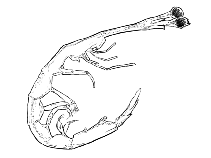Lucifer typus Milne-Edwards, 1837
| Native range | All suitable habitat | Point map | Year 2050 |

|
| This map was computer-generated and has not yet been reviewed. |
| Lucifer typus AquaMaps Data sources: GBIF OBIS |
Classification / Names Common names | Synonyms | CoL | ITIS | WoRMS
Malacostraca | Decapoda | Luciferidae
Environment: milieu / climate zone / depth range / distribution range Ecology
Pelagic; depth range 0 - 732 m (Ref. 78965). Tropical; 70°N - 42°S, 180°W - 180°E
Distribution Countries | FAO areas | Ecosystems | Occurrences | Introductions
Atlantic, the Mediterranean and Indo-Pacific.
Length at first maturity / Size / Weight / Age
Maturity: Lm ? range ? - ? cmCommon length : 1.2 cm TL male/unsexed; (Ref. 97328); common length :1.2 cm TL (female)
Short description Morphology
The length of the neck is greater than the length of the eye stalk. The eye stalks are long and slender. Length of the first antennular segment reaches to the edge of the comea. Length of the rostrum reaches only to the base of the eye stalk. The terminal portion of the sheath of the petasma is broad, flat and obliquely rounded, with a rudimentary protuberance and enclosed with a very conspicuous long hook. The lamelliform processus ventralis is distinct; the bottom of the deep terminal incision is transverse between the two horns. The anterior ventral process on the sixth abdominal segment in male is almost as long as the posterior process and slender, but the swollen distal part of the posterior process is bent considerably upwards. In the male telson the swollen section, the ventral protuberance, is large. The posterior margin of the ventral protuberance is somewhat remote from the end of the telson. The end of the telson narrows abruptly after the last pair of lateral spines on the telson. There are three pairs of spines on the tip of the telson. The outer pair of the spines are the longest but shorter than the width of the tip of the telson, each of the long spine has 4 spinules on the first half of the inside edge. The two pairs of inner spines do not have any spinules. The apical process of the terminal margin of the exopod of uropod is moderately long and deeply curved in male. In female the exopod is five times as long as broad; the end is oblique and the marginal apical process is smaller than in male.
Minimum depth from Ref. 96905. Planktonic (Refs. 75706, 97477). Motile suspension feeder (Ref. 125928).
Life cycle and mating behavior Maturity | Reproduction | Spawning | Eggs | Fecundity | Larvae
Females carry loosely packed clusters of eggs attached to the ischia of the third pereiopods; these eggs remain attached until the nauplii emerges, which lasts for more or less 36 hours. The nauplius hatches out of the egg, it then undergoes protozeal and mysis stage into the post larva, juvenile and then to adult (Ref. 97328).
Main reference
References | Coordinator | Collaborators
Pérez Farfante, I. and B. Kensley. 1997. (Ref. 75620)
IUCN Red List Status (Ref. 130435)
CITES status (Ref. 108899)
Not Evaluated
CMS (Ref. 116361)
Not Evaluated
Threat to humans
Human uses
| FishSource |
Tools
More information
Internet sources
BHL | BOLD Systems | CISTI | DiscoverLife | FAO(Publication : search) | Fishipedia | GenBank (genome, nucleotide) | GloBI | Gomexsi | Google Books | Google Scholar | Google | PubMed | Tree of Life | Wikipedia (Go, Search) | Zoological Record
Estimates based on models
Preferred temperature
(Ref. 115969): 9.2 - 23.6, mean 15.1 (based on 1659 cells).
Price category
(Ref. 80766):
Unknown.



